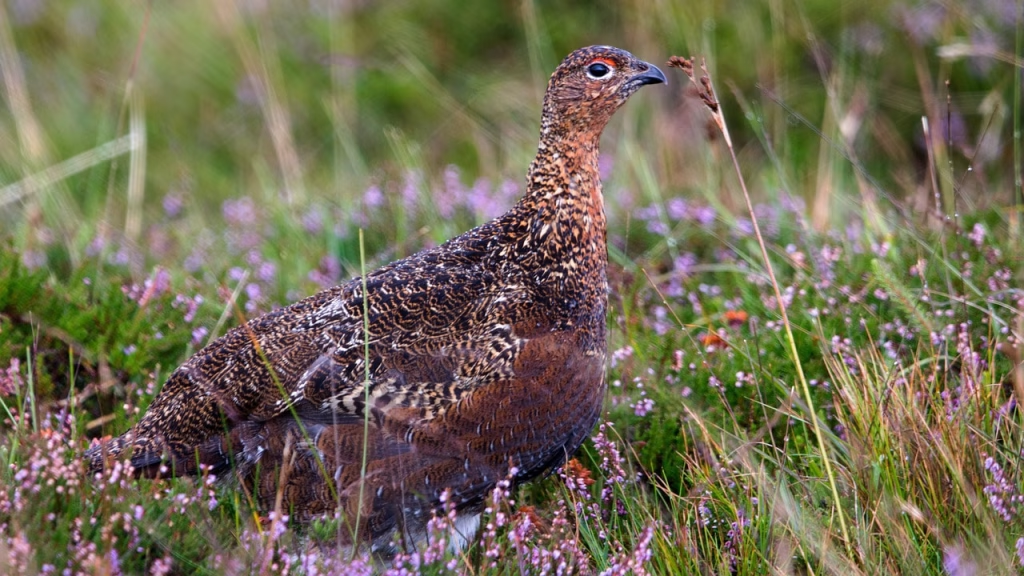Grouse shooting and rewilding

Grouse moors cover 852,000 acres of our national parks, an area over twice the size of Greater London. Great, sweeping moors that are suffering the consequences of human exploitation. In our national parks, where nature ought to be thriving, the practices around grouse moors are contributing towards the sixth extinction event and reducing the land’s resilience in the face of the climate crisis.
Wild Moors has been working tirelessly for years to raise the profile of grouse moors and their ecological state in the public consciousness, and to help a shift towards rewilding, and League Against Cruel Sports is campaigning National Parks to think about what is it they are for – hunting or nature? On a finite island, where we need land to build our houses on, grow our food, provide clean water, clean air and capture carbon, can we spare the room?
First off, and one of the most important points, grouse moors do not contribute towards the food security of the UK. They are purely for bloodsports. Arguments surrounding land use are many and complex, but often one of the biggest issues surrounding rewilding is taking land out of food production. Grouse moors are not land for food production, purely for sport. 1.4% of the entire land of Britain is given over to ecologically damaging practices such as burning peat and ‘predator control’.
Burning, also known as ‘swaling’, is done to burn off vegetation, allowing fresh shoots of heather to grow, which are a food source for the young grouse. However, burning dries out the peat, releases huge amounts of carbon into the air, and reduces the land’s ability to absorb water, leading to catastrophic floods and droughts.
Burning also reduces plant diversity in species and in age, which is critical for providing food sources for a variety of different birds, mammals and invertebrates, and for a fully-functioning ecosystem.
Alongside this, grouse moors are closely linked with raptor persecution and wildlife crimes. Intolerant of anything that may kill the grouse before humans can, our birds of prey such as hawks, kites and eagles have been poisoned and shot, and snares set which capture badgers, foxes, otters, as well as any dogs, cats and even humans that find themselves in the wrong area.
We can see what a terrible effect it has on our wildlife, the climate and anyone unlucky enough to live downstream and at risk of flooding and drought. But do they bring in money to the local economy? What benefits do they bring?
Unfortunately, none there either. Grouse moors are unprofitable, providing little in the way of money through tourism or regular employment, and it has been shown that turning grouse moors, our degraded uplands, over to rewilding would benefit the local economy and the public purse.
There is a growing trend for grouse moor owners to either sell to rewilders or turn to rewilding themselves in an effort to recoup their losses. We can only hope that this trend continues.
In our country there is a huge amount of land that could easily be rewilded, that loses nothing by returning it to nature, except depriving a few individuals their chance at ‘sport’, and provide so much more instead. It’s a clear opportunity to create a more resilient Britain as the climate crisis deepens, provide green jobs and allow nature to flourish, for all of us to enjoy.
Our blog posts are written by our core team and guest bloggers. If you have an idea for a blog post please pitch it to us: info@wildcard.land
CAMPAIGNS
ARCHIVES
- December 2025
- November 2025
- October 2025
- September 2025
- August 2025
- July 2025
- June 2025
- May 2025
- April 2025
- March 2025
- February 2025
- December 2024
- November 2024
- October 2024
- September 2024
- August 2024
- July 2024
- June 2024
- March 2024
- February 2024
- January 2024
- December 2023
- November 2023
- August 2023
- July 2023
- May 2023
- February 2023
- January 2023
